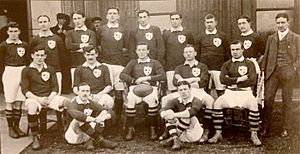Ernest Deane facts for kids
 |
|||||||||||||||||
| Date of birth | 4 May 1887 | ||||||||||||||||
|---|---|---|---|---|---|---|---|---|---|---|---|---|---|---|---|---|---|
| Place of birth | Limerick, Ireland | ||||||||||||||||
| Date of death | 25 September 1915 (aged 28) | ||||||||||||||||
| Place of death | Neuve Chapelle, France | ||||||||||||||||
| School | Corrig School, Kingstown, Co Dublin | ||||||||||||||||
| University | Royal College of Surgeons in Ireland | ||||||||||||||||
| Rugby union career | |||||||||||||||||
|
|||||||||||||||||
| ---- | |||||||||||||||||
| Military career | |||||||||||||||||
| Buried |
Rue-du-Bacquerot No 1 Military Cemetery, Laventie (II.D.14)
(50°36′16″N 2°46′06″E / 50.60436°N 2.76823°E) |
||||||||||||||||
| Allegiance | |||||||||||||||||
| Service/ |
|||||||||||||||||
| Years of service | 1911–15 | ||||||||||||||||
| Rank | Captain (Medical Officer) | ||||||||||||||||
| Unit | 2 Royal Leicestershire Regiment | ||||||||||||||||
| Battles/wars | First World War | ||||||||||||||||
| Awards |
|
||||||||||||||||
Ernest Cotton Deane (born May 4, 1887 – died September 25, 1915) was a brave doctor in the British Indian Army. He was also a talented rugby player who played for Ireland internationally.
Ernest was born in Limerick, Ireland. He went to school in Kingstown, which is now called Dún Laoghaire. After school, he studied medicine at the Royal College of Surgeons in Ireland (RCSI). He finished his studies in 1909. In February 1909, he played one rugby match for Ireland against England. Sadly, his rugby career ended early when he broke his leg.
In 1911, Ernest became a doctor in the army. He was sent to India in 1913 and served in Burma. When the First World War began, he went to France with the Indian army. He worked as a medical officer, helping injured soldiers. He was awarded the Military Cross for his bravery. He died in battle in September 1915 while helping wounded soldiers.
Early Life and Education
Ernest Deane was born in Limerick, Ireland, on May 4, 1887. He was the third of four sons of Thomas and Aileen Deane. His family lived in Kingstown, County Dublin, which is now known as Dún Laoghaire.
From 1901 to 1904, Ernest attended Corrig School in Kingstown. After that, he decided to study medicine. He went to the Royal College of Surgeons in Ireland (RCSI) from 1904 to 1909. After graduating, he worked as a house surgeon at the Adelaide Hospital in Dublin.
Ernest's Rugby Career
Ernest Deane was a very good all-round sportsman. He enjoyed golf, lawn tennis, horse-riding, and shooting. He was also a fantastic rugby player. At Corrig School, he was the captain of the rugby team. Later, he captained the teams for Adelaide Hospital and the Monkstown club.
He was chosen to play as a "wing" for the Ireland team. This was for a match against England on February 13, 1909. The game was played in Dublin at Lansdowne Road. Ireland lost the match 5–11. It was England's first win in Ireland since 1895.
In November 1909, Ernest was playing for Monkstown against Oxford University. During the game, he had an accident and broke his leg. This injury sadly brought his promising rugby career to an end.
Military Service in World War I
At the start of the 1900s, many Irish doctors joined the British armed forces. Ernest Deane became a temporary lieutenant in the Royal Army Medical Corps (RAMC) in July 1911. His position was made permanent in February 1912.
In October 1913, he was sent to India and served in Burma. When the First World War started, he was stationed in Meerut. He then traveled to France with the Indian Expeditionary Force. They arrived in Marseille in September 1914. Ernest was sent straight to the Western Front. He first worked with the 20th Field Ambulance unit. Later, he became the medical officer for the 2nd Battalion of The Royal Leicestershire Regiment. His unit saw a lot of fighting.
A few days before he died, Ernest was awarded the Military Cross. This award is given for bravery in battle. He was one of 60 doctors from his college (RCSI) to receive this honor during the war.
On September 25, 1915, Ernest's battalion took part in the Battle of Loos. This was a major battle where they tried to distract German forces. The fighting was very intense, and many soldiers were hurt. Ernest went out to help some injured soldiers. While returning, he was shot and killed instantly. Because of his brave actions, he was mentioned in official reports.
Captain Ernest Deane was one of 17 doctors from the RCSI who died in action during the war. He is buried in the Rue-du-Bacquerot No 1 Military Cemetery in Laventie, France.
See also
- List of international rugby union players killed in action during the First World War


